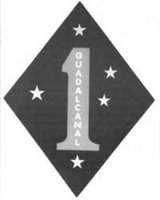 we will continue on with Guadalcanal. Tonight will begin the first post of:
we will continue on with Guadalcanal. Tonight will begin the first post of:FIRST OFFENSIVE: The Marine Campaign for Guadalcanal
Admiral McCain visited Guadalcanal at the end of August, arriving in time to greet the aerial reinforcements he had ordered forward, and also in time for a taste of Japanese nightly bombing. He got to experience, too, what was becoming another unwanted feature of Cactus nights: bombardment by Japanese cruisers and destroyers. General Vandegrift noted that McCain had gotten a dose of the "normal ration of shells." The admiral saw enough to signal his superiors that increased support for Guadalcanal operations was imperative and that the "situation admits no delay whatsoever." He also sent a prophetic message to Admirals King and Nimitz+: "Cactus can be sinkhole for enemy air power and can be consolidated, expanded, and exploited to the enemy's mortal hurt."
On 3 September, the Commanding General, 1st Marine Aircraft Wing, Brigadier General Roy S. Geiger, and his assistant wing commander, Colonel Louis Woods, moved forward to Guadalcanal to take charge of air operations. The arrival of the veteran Marine aviators provided an instant lift to the morale of the pilots and ground crews. It reinforced their belief that they were at the leading edge of air combat, that they were setting the pace for the rest of Marine aviation. Vandegrift could thankfully turn over the day-to-day management of the aerial defenses of Cactus to the able and experienced Geiger. There was no shortage of targets for the mixed air force of Marine, Army, and Navy flyers. Daily air attacks by the Japanese, coupled with steady reinforcement attempts by Tanaka's destroyers and trrts, meant that every type of plane that could lift off Henderson's runway was airborne as often as possible. Seabees had begun work on a second airstrip, Fighter One, which could relieve some of the pressure on the primary airfield.
+remember this name.
No comments:
Post a Comment